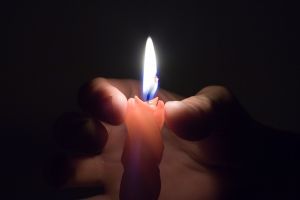Domenikos Theotokopoulos was born in the city of Candia on the island of Crete, a city now called Iráklion. He lived from 1541 to 1614. He is better known as El Greco.
The latter name means “the Greek.” It is a strange combination of the Italian word “Greco,” which means “Greek,” and the Spanish definite article “el.” In modern Italian, the artist’s nickname would be “Il Greco,” and I am pretty sure that the applicable masculine singular definite article was the same word “il” at the time when El Greco lived. At least, John Milton, who lived not too much later than El Greco, called one of his poems “Il Penseroso.
El Greco spent the early years of his life in his native Crete. Then he worked in Italy for a few years, first in Venice, then at Rome. Finally he settled in Toledo, Spain, where he spent the last 37 years of his life.
His wanderings explain the unusual form of his nickname. He adopted the name “Dominico Greco” while in Italy, and apparently continued to use this Italian name while in Spain. Since people like to shorten names in ordinary conversation, the Spanish would naturally apply their own definite article to the last part of the name that the artist was using.
Cretan Period
There is little information available concerning El Greco’s early years in Crete, but one document reveals that he became adept at painting icons, which were religious paintings depicting such scenes as Mary holding the infant Jesus. A significant feature of these icons was their flat, two dimensional style. There was no attempt to portray depth. This type of painting is known as the Byzantine style.
Not many of El Greco’s early paintings are currently known. Either they did not survive the ravages of time, or else they exist as anonymous works of art. My excellent book entitled “El Greco” by Michael Scholz-Hänsel reproduces only two paintings from this period in the artist’s life. One is “The Dormition of the Virgin,” which El Greco painted for a church in Syros, an island in the Aegean Sea. “Dormition” refers to the moment when Mary succumbed to the sleep of death.
According to the beliefs of the Greek Orthodox Church and the Roman Catholic Church, Mary’s body was borne to heaven to be reunited with her soul after she died. For this reason, celestial beings on a gold background occupy the center of the painting. They evidently have come to earth to attend Mary as her body is born to heaven. In the center of these celestial figures is the Holy Spirit in the form of a dove. Below this central scene, Jesus is bending over Mary, who is lying on a sort of cot or mattress with her head to the right of the painting and her feet to the left. A group of people are standing on each side of the painting, one to the right of Mary’s head and another to the left of her feet. The top of the picture portrays heaven, which is predominantly golden.
Most of this picture is in the two dimensional style customary in Byzantine icons. However, the groups of people standing to the right and to the left of Mary appear to be three dimensional. At least, that is my impression.
El Greco in Italy
During El Greco’s lifetime, Crete was a possession of the Republic of Venice, so it is not surprising that El Greco moved to Venice. Sources disagree on the exact year. The author of my book thinks that it was 1567.
The long-lived Titian was the dominant painter in Venice at this time. His style is characterized by an effective application of light and color. Moreover, Italian artists, including Titian, had applied the principle of perspective to their paintings for many years.
El Greco changed his painting style to conform to Venetian practices. Critics see the influence of Titian in the paintings that he produced at this time. In fact, one contemporary document calls him a disciple of Titian. Titian was old at the time when El Greco came to Venice. He died in 1576 after a life that lasted nearly 100 years.
In my book, there are two different versions of a paining entitled “Christ Healing the Blind.” The author believes that the first was painted in Venice, the second in Rome.
In this picture, Jesus is touching the eyes of a blind man who is kneeling on one knee before Him. To me, it seems that the artist made effective use of light and color, and the entire scene is three dimensional. The people standing in the foreground are lifelike, The buildings on the upper right of the picture appear to be near because of their large size, and the hills on the upper left appear far away because of their small size. The artist has painted a blue sky with fluffy clouds above these hills. The color of the sky and clouds form a pleasant contrast with the darker buildings to the right.
After about three years, El Greco moved to the city of Rome. Critics say that the works of Michelangelo began to influence his own paintings. Michelangelo had died in 1564, but El Greco undoubtedly saw his works in Rome.
The influence of Michelangelo is apparent in his painting entitled “Pietà,” which features Mary holding the body of Jesus, with the help of other people. This group of figures forms a sort of pyramid with Mary’s head at the peak. This arrangement is reminiscent of the pyramidal structure in a marble sculpture of Michelangelo called the “Pietà.” However, in Michelangelo’s work, Joseph of Arimathia occupies the highest spot in the pyramid.
El Greco in Spain
When I first saw some of El Greco’s works many years ago, I noted the long faces of many of the subjects, and in general, I thought that his pictures looked weird. Distortions do occur in many of the works that El Greco executed in Spain. His “A View of Toledo” features an eerie sky in dark blue and black interspersed with lighter blue and white. Beneath the sky is an eerie dark green landscape with a few Toledo structures perched on an eminence.
I actually like the Toledo picture, and most of El Greco’s works do not look so weird to me now, probably because I am used to seeing them. Critics generally say that his distortions are designed to emphasize the spirituality of the subject.
One of his most famous paintings is “The Burial of the Count of Orgaz.” My book points out that this picture is divided into two zones: an earthly scene on the bottom of the painting, where the body is carried by St. Stephen and St. Augustine, and a heavenly scene above, which includes the soul of the Count of Orgaz. Looking at the picture, I find that El Greco provided a very effective boundary between these two zones. Observers are standing in a row behind the body and the two saints, and their heads form a somewhat jagged horizontal line across the canvas. Above this row of heads is heaven; below it is the earthly scene.
I have never cared for nude paintings, and one thing that I appreciate about El Greco is the fact that his figures usually wear decent clothes. There are exceptions, such as a painting called “Laocoön,” but most of the works of El Greco are suitable for the eyes of children.
Reference
“El Greco” by Michael Scholz-Hänsel




